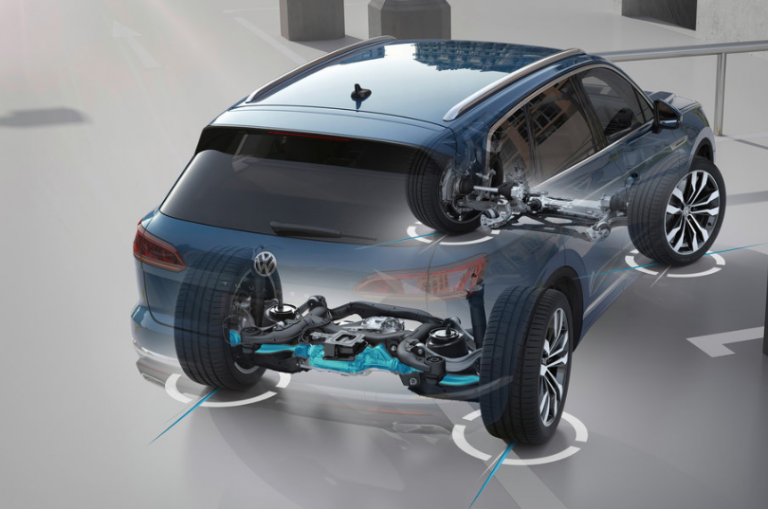

Over the long life of the automobile, technologies have come and gone like steering with all four wheels, evolved and improved with the times. One technology that many don’t know exists is the four-wheel steering (4WS) system. First available in the US in the 1988 Honda Prelude, this technology didn’t exactly explode in popularity as car manufacturers had hoped but many vehicles offered it. By the early 2000’s, 4WS seemed like a thing of the past.
However, four-wheel steering has started making a small comeback over the past few years with much improved systems. Variations of it can be found in certain models by Porsche, Audi, BMW, Mercedes, Lexus, Ferrari, Lamborghini and Tesla.
Depending on the application, it’s a technology that some enthusiasts specifically seek out, while others avoid it or take pains to disable such systems. Once purely practical, four-wheel steering is a largely now a performance feature to improve handling on sports cars. Let’s dig into how it works, how it came to be, and why it’s made a comeback in recent years.
The 1980s were the Jurassic Park of Japanese car design. Engineers were so preoccupied with whether or not they could that they didn’t stop to think if they should. Advanced technology was a hallmark of 1980s-era cars from Japan. While Honda was one of the more conservative marques when it came to styling, it enjoyed a reputation for innovative technical solutions, like the emissions-reducing CVCC engine. Active four-wheel steering was pioneered by Nissan on that company’s home-market 1986 Skyline, but the first automaker to sell a four-wheel-steer car in the U.S. was Honda: the 1988 Prelude Si 4WS. That variant, available throughout the third-generation Prelude’s run, was expensive to buy new, but after years of being underappreciated, it’s growing in value now.
Its fully mechanical design differed from the hydraulic-mechanical and electric-hydraulic systems used by Nissan, as well as by Mazda on the 1988 626 Turbo 4WS that followed the Prelude Si 4WS to our market. And the benefit to Honda’s sharp-looking, 2.0-liter DOHC 135-hp two-door was a turning circle cut from 34.8 to 31.5 feet, plus enhanced maneuverability and stability.
Stability, maneuverability, easy entry into sharp turns and high agility are the outstanding characteristics of the car. Musk said that in order to achieve all these parameters, Tesla Cybertruck will be equipped with a 4-wheel steering system.
The new Touareg is the first Volkswagen with optional all-wheel steering. This system makes the Touareg one of the most agile large SUVs.
Driving scenario one: At speeds up to 37 km/h, the rear wheels turn automatically at an opposing angle to the front ones. In other words, when the front wheels veer left, the electrically controlled rear axle steers to the right by up to five degrees. This improves the vehicle’s manoeuvrability. The all-wheel steering system reduces the turn radius from 12.19 to 11.19 metres, something which is particularly noticeable when it comes to parking. Manoeuvring with a trailer in tow is also made easier. One of the highlights here is the new combination of all-wheel steering and Trailer Assist – a trailer maneouvring system that steers virtually automatically. Thanks to the interplay between these two features, guiding the vehicle and trailer duo is a walk in the park, even in the tightest of spaces.
Driving scenario two: If the vehicle is travelling faster than 37 km/h, the rear wheels turn in the same direction as the front ones during steering. This once again makes for smoother handling, especially at the kind of speeds reached on country roads and motorways, as the all-wheel steering system provides stability when changing lanes (during quick overtaking, for example). The same goes for sudden evasive manoeuvres.
The purpose of using an all-wheel steering system is to gain more agility of the vehicle. When traveling at a slower speed, the rear wheels of the car are going to turn opposite of the front wheels slightly. This tactic is known as counter-phase steering. It permits the vehicle to maintain a tighter turning radius, allowing for superior agility.
All-wheel steering enhances the steering response at lower speeds while allowing better stability when driving at higher speeds.

Obviously, you can’t have all four wheels turn in the same direction at the same angle at any speed. That would result in disaster. So instead, this system is heavily dependent on vehicle speed.
At low speeds (under 35 MPH or so), the rear wheels turn in the opposite direction as the front wheels. This is referred to as “counter-phase” steering and allows the vehicle to take tighter turns than if only the wheels on the front axle were turning. This is a big help in situations like U-turns and parallel parking, especially for longer vehicles.
At higher speeds, the rear wheels turn slightly in the same direction as the front wheels. This is referred to as “in-phase” steering. The benefit is that the vehicle feels more stable, especially when changing lanes or going through high speed corners (whether on the highway or track).